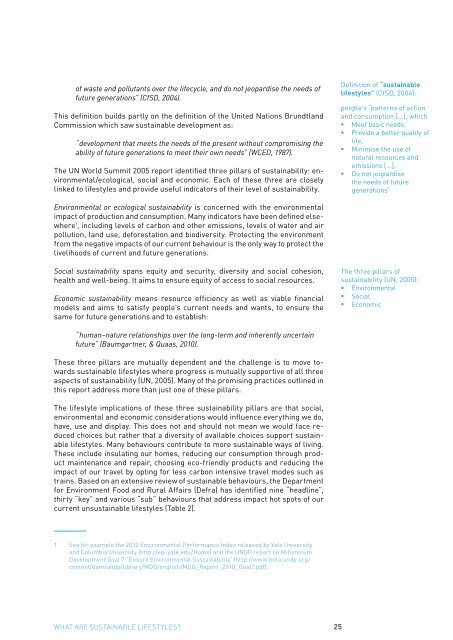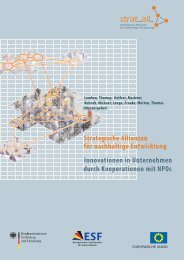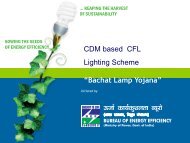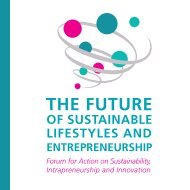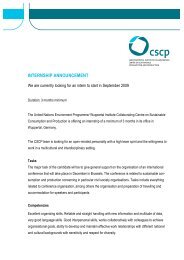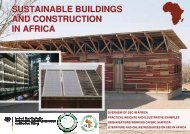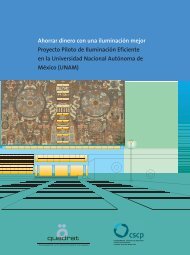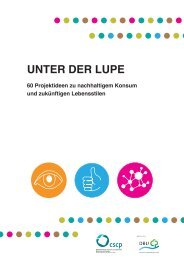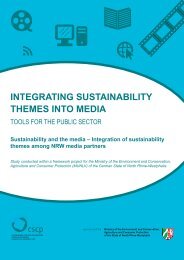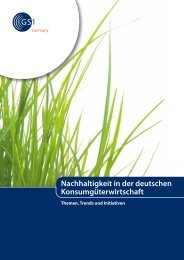today's facts & tomorrow's trends - SPREAD Sustainable Lifestyles ...
today's facts & tomorrow's trends - SPREAD Sustainable Lifestyles ...
today's facts & tomorrow's trends - SPREAD Sustainable Lifestyles ...
You also want an ePaper? Increase the reach of your titles
YUMPU automatically turns print PDFs into web optimized ePapers that Google loves.
of waste and pollutants over the lifecycle, and do not jeopardise the needs of<br />
future generations” (CfSD, 2004).<br />
This definition builds partly on the definition of the United Nations Brundtland<br />
Commission which saw sustainable development as:<br />
“development that meets the needs of the present without compromising the<br />
ability of future generations to meet their own needs” (WCED, 1987).<br />
The UN World Summit 2005 report identified three pillars of sustainability: environmental/ecological,<br />
social and economic. Each of these three are closely<br />
linked to lifestyles and provide useful indicators of their level of sustainability.<br />
Definition of “sustainable<br />
lifestyles” (CfSD, 2004):<br />
people’s “patterns of action<br />
and consumption [...], which<br />
• Meet basic needs,<br />
• Provide a better quality of<br />
life,<br />
• Minimise the use of<br />
natural resources and<br />
emissions [...],<br />
• Do not jeopardise<br />
the needs of future<br />
generations”<br />
Environmental or ecological sustainability is concerned with the environmental<br />
impact of production and consumption. Many indicators have been defined elsewhere<br />
1 , including levels of carbon and other emissions, levels of water and air<br />
pollution, land use, deforestation and biodiversity. Protecting the environment<br />
from the negative impacts of our current behaviour is the only way to protect the<br />
livelihoods of current and future generations.<br />
Social sustainability spans equity and security, diversity and social cohesion,<br />
health and well-being. It aims to ensure equity of access to social resources.<br />
Economic sustainability means resource efficiency as well as viable financial<br />
models and aims to satisfy people’s current needs and wants, to ensure the<br />
same for future generations and to establish:<br />
The three pillars of<br />
sustainability (UN, 2005):<br />
• Environmental<br />
• Social<br />
• Economic<br />
“human–nature relationships over the long-term and inherently uncertain<br />
future” (Baumgartner, & Quaas, 2010).<br />
These three pillars are mutually dependent and the challenge is to move towards<br />
sustainable lifestyles where progress is mutually supportive of all three<br />
aspects of sustainability (UN, 2005). Many of the promising practices outlined in<br />
this report address more than just one of these pillars.<br />
The lifestyle implications of these three sustainability pillars are that social,<br />
environmental and economic considerations would influence everything we do,<br />
have, use and display. This does not and should not mean we would face reduced<br />
choices but rather that a diversity of available choices support sustainable<br />
lifestyles. Many behaviours contribute to more sustainable ways of living.<br />
These include insulating our homes, reducing our consumption through product<br />
maintenance and repair, choosing eco-friendly products and reducing the<br />
impact of our travel by opting for less carbon intensive travel modes such as<br />
trains. Based on an extensive review of sustainable behaviours, the Department<br />
for Environment Food and Rural Affairs (Defra) has identified nine “headline”,<br />
thirty “key” and various “sub” behaviours that address impact hot spots of our<br />
current unsustainable lifestyles (Table 2).<br />
1 See for example the 2010 Environmental Performance Index released by Yale University<br />
and Columbia University (http://epi.yale.edu/Home) and the UNDP report on Millennium<br />
Development Goal 7 “Ensure Environmental Sustainability’ (http://www.beta.undp.org/<br />
content/dam/undp/library/MDG/english/MDG_Report_2010_Goal7.pdf).<br />
What are sustainable lifestyles? 25


